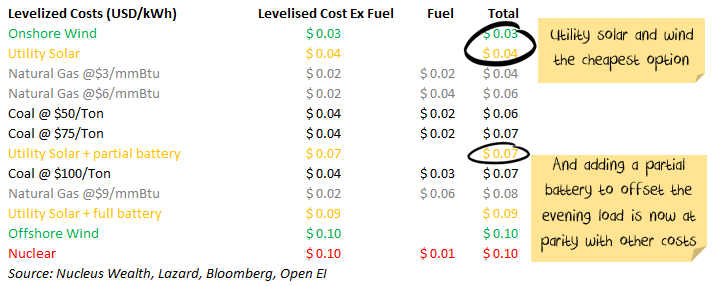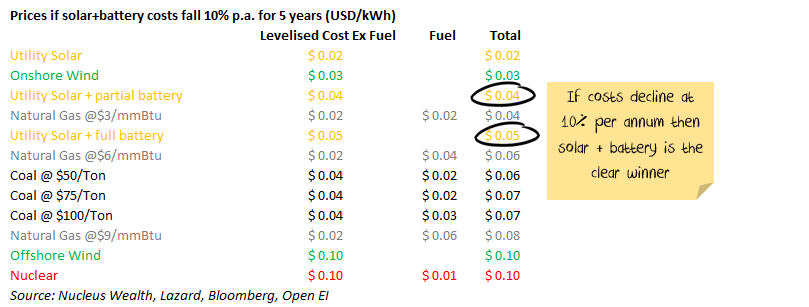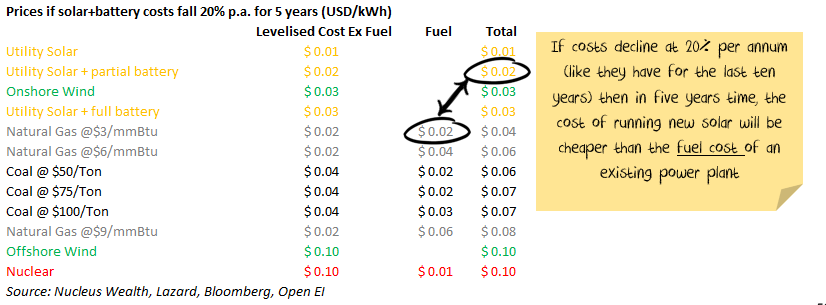Via the ABC:
The Federal Government’s planned gas-led recovery could turn out to be a mirage, according to energy experts who question the economic case for investing in gas infrastructure when fossil fuels are being rapidly replaced by renewable energy sources.
In September, Prime Minister Scott Morrison announced a plan to “reset the east coast gas market” by “unlocking gas supply” and “delivering an efficient pipeline and transportation market” to drive the nation’s economic recovery.
Mr Morrison also issued a warning to electricity companies.
“To ensure affordable, reliable power, we need the market to deliver 1000 megawatts of new dispatchable capacity,” he said.
“If not, my Government will step up and we will fill the gap.”
The Prime Minister said the government-owned Snowy Hydro company would build a gas generator in the Hunter Valley if the electricity sector failed to meet the energy shortfall left by the scheduled closure of the coal-fired Liddell power plant in New South Wales.
Yet the energy market operator has revealed that several planned projects in the state would exceed the interim reliability shortfall.
“Let’s be clear,” Minister for Energy and Emissions Reduction Angus Taylor told 7.30.
“The market operator said there’s a reliability gap of substantially more than that when you go out a few extra years.
“But we’re also focused on affordability, not just reliability.
“We’re losing up to 1,600 megawatts of capacity when Liddell closes.
Tony Wood, energy director at the Grattan Institute, told 7.30 that promoting a gas-led recovery was “quite an extraordinary step and almost certainly unnecessary”.
“The wish that gas prices would one day be as cheap as they used to be, is almost certainly doomed,” Mr Wood said.
“Building long-term gas infrastructure, it almost certainly will be a stranded asset at some point in the future.
“A gas-led recovery is likely to turn out to be a mirage, to be honest.”
A ‘reckless’ and ‘dangerous’ course of action
Jillian Broadbent, former chair of the Clean Energy Finance Corporation, described the Government’s planned intervention as “reckless” and “a dangerous decision”.
Ms Broadbent said she too was concerned that gas infrastructure such as pipelines and gas hubs could become stranded assets.
The Australian Petroleum Production and Exploration Association (APPEA), which represents Australia’s oil and gas producers, told 7.30 its members were well-placed to drive the economic recovery.
“In the last decade, our industry invested $350 billion in Australia in projects for both domestic supply and export to our trading partners in Asia,” it said.
“Supporting a gas-led recovery doesn’t mean we’re looking for direct financial support from the Government or that we’re asking for other energy sources to be excluded from the mix.”
Ultimately, the states and territories might undermine the Federal Government’s gas plan with their own renewable energy plans.
NSW Energy and Environment Minister Matt Kean described gas as “actually a very expensive way of generating electricity”.
“My focus is on ensuring the families and businesses of this state get access to the cheapest forms of reliable energy,” Mr Kean said.
“We’re taking a technology-neutral approach to that, and in doing so we know that the cheapest forms of reliable energy are wind, solar, pumped hydro and batteries.”
Where our electricity comes from now, and tomorrow
The National Energy Market generates almost 200 terawatt hours (TWh) of energy each year to power households and businesses.
Coal still accounts for 68 per cent of the energy mix, but is on the decline, with 10 coal-fired power stations having closed since 2012.
Seven of the remaining 16 coal-fired stations in the national energy market are expected to close over the next 20 years.
Renewables, such as wind, hydro, grid-scale and rooftop solar and batteries, currently account for almost 24 per cent of our energy generation annually.
Gas currently accounts for 8 per cent.
The forecast for gas, according to the energy market operator, is to play a supporting though declining role as Australia transitions to new renewable energy sources.
While residential and commercial gas consumption has risen, total domestic consumption in eastern Australia has declined 21 per cent since 2014, when gas exports took off, and the domestic gas price rose.
“That record level of investment we’ve seen in solar and wind in recent years, is all about bringing down our emissions. But we need to have those complementary dispatchable energy sources.”
Santos set to drill wells in Narrabri
Despite 23,000 submissions, the majority of them objecting to the project, Australia’s largest domestic gas supplier Santos has received NSW Independent Planning Commission (IPC) approval to drill up to 850 gas wells in northern NSW.
Mr Taylor said the Narrabri gas development was one of many different projects across the country that were needed to deliver more affordable gas.
“We need that supply,” he said.
Santos chief executive Kevin Gallagher said the project would access an “abundant energy source” to increase manufacturing and industrial capacity, and that “no gas project could lead to higher gas prices”.
“One of the benefits of the Narrabri gas project in particular, is that it will bring gas closer to those New South Wales markets. The suppliers, the sort of buyers, [are] the manufacturers, the industrial users,” Mr Gallagher said.
However, local landholder and one-time Greens candidate Peter Willis has concerns about the approval process.
“I don’t believe Santos or the IPC would have had enough time to go through all the tens of thousands of submissions, with proper due diligence,” he said.
Mr Gallagher disagreed and noted “the vast majority” of submissions were “form submissions by the same sort of core people submitting them”.
A proposed high-pressure underground pipeline connecting the Narrabri gas field to the Hunter Valley has NSW Government approval to cross Mr Willis’s land near Quirindi.
A pipeline to nowhere?
The pipeline’s proponent, Garbis Simonian from Hunter Gas Pipeline, must now negotiate access for a maintenance easement with up to 500 landholders.
Farmers like Mr Willis have objected to giving workmen access to their properties.
“We hope our initial refusal of access to our paddocks is sufficient for them not to be able to prove to the Government they can gain the easements in the first instance,” he said.
The pipeline will run right through the Hunter electorate of Labor MP Joel Fitzgibbon.
Mr Fitzgibbon said he supported the pipeline because it would provide “economic opportunity for my people”.
“My interest is in the reliable and affordable gas it provides and the jobs that will flow from that,” he said.
But retirees Susan and Roland Johnson, who knew the pipeline had approval to cross their land when they bought their property at Stanhope in the Hunter Valley, are worried the pipeline will become a white elephant.
The pipeline’s expected route was changed and is now closer to their home.
“Why spend billions of dollars on what will become a stranded asset?” Mrs Johnson asked.
Quite right. There now has to severe doubts about any and all of the Gas Unplan, which was really just an excuse for the corrupt Narrabri project anyway. Add to the above the new NSW renewables plan that explicitly unwrites the development of 2GW of power storage. That will not be enough to end gas given powering the state for an hour by itself will not be enough from time-to-time amid the duck curve and occasional intermittency issues (we’d probably need three hours worth to finish gas off) but it’ll be plenty most of the time rendering gas production occasional at best.
That is enough to guarantee no more construction of gas turbines. And if the Morrison Government goes ahead with its intention of building them then by definition it will be building assets that are virtually never used. That is, they’ll be stranded. So why would anybody invest in expensive Narrabri gas, either? It will also be stranded. Gas can’t compete on any level playing field today:
Tomorrow it’s completely buggered. By that, I mean 400% more expensive than renewables within five years!
A much better idea is to install LNG imports terminals that are cheaper and can ratchet down quickly as gas goes the way of oil over the next three decades.
The simple truth is, energy policy all by itself proves hands down that the federal Coalition is the worst economic manager imaginable.




